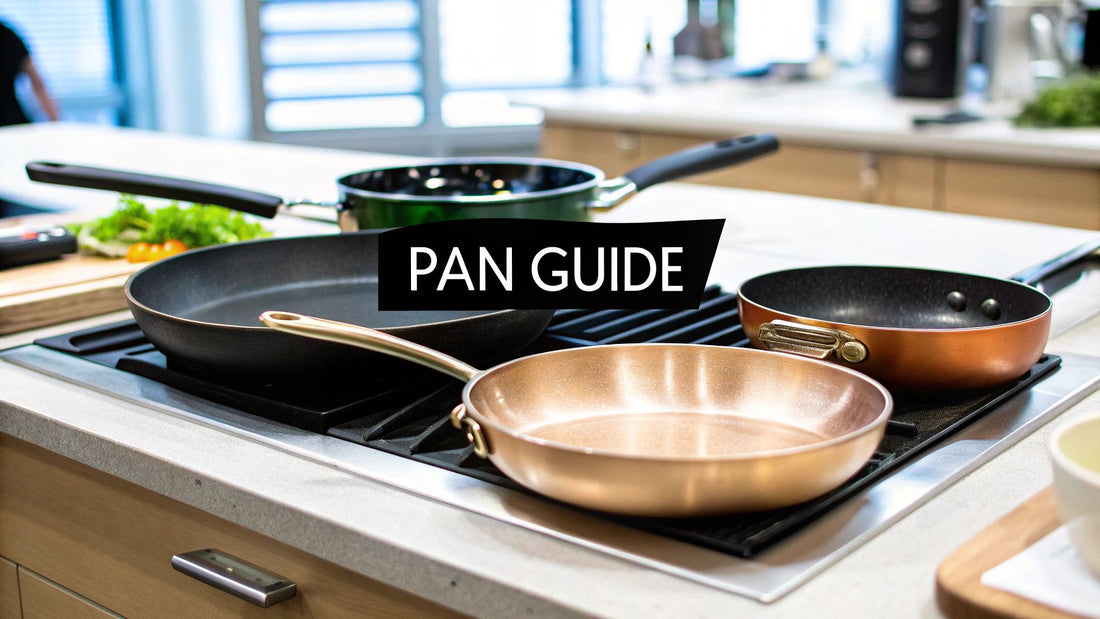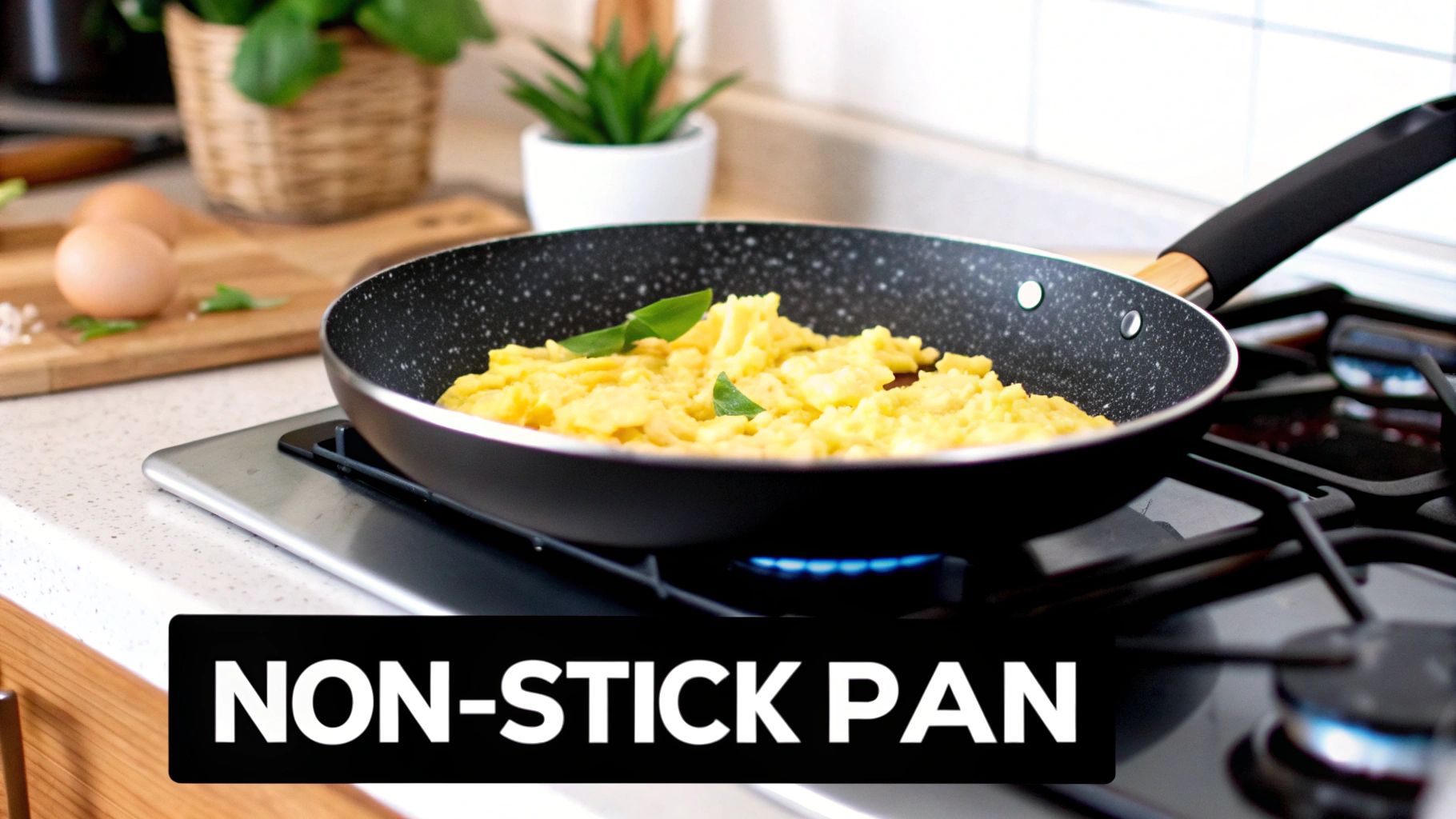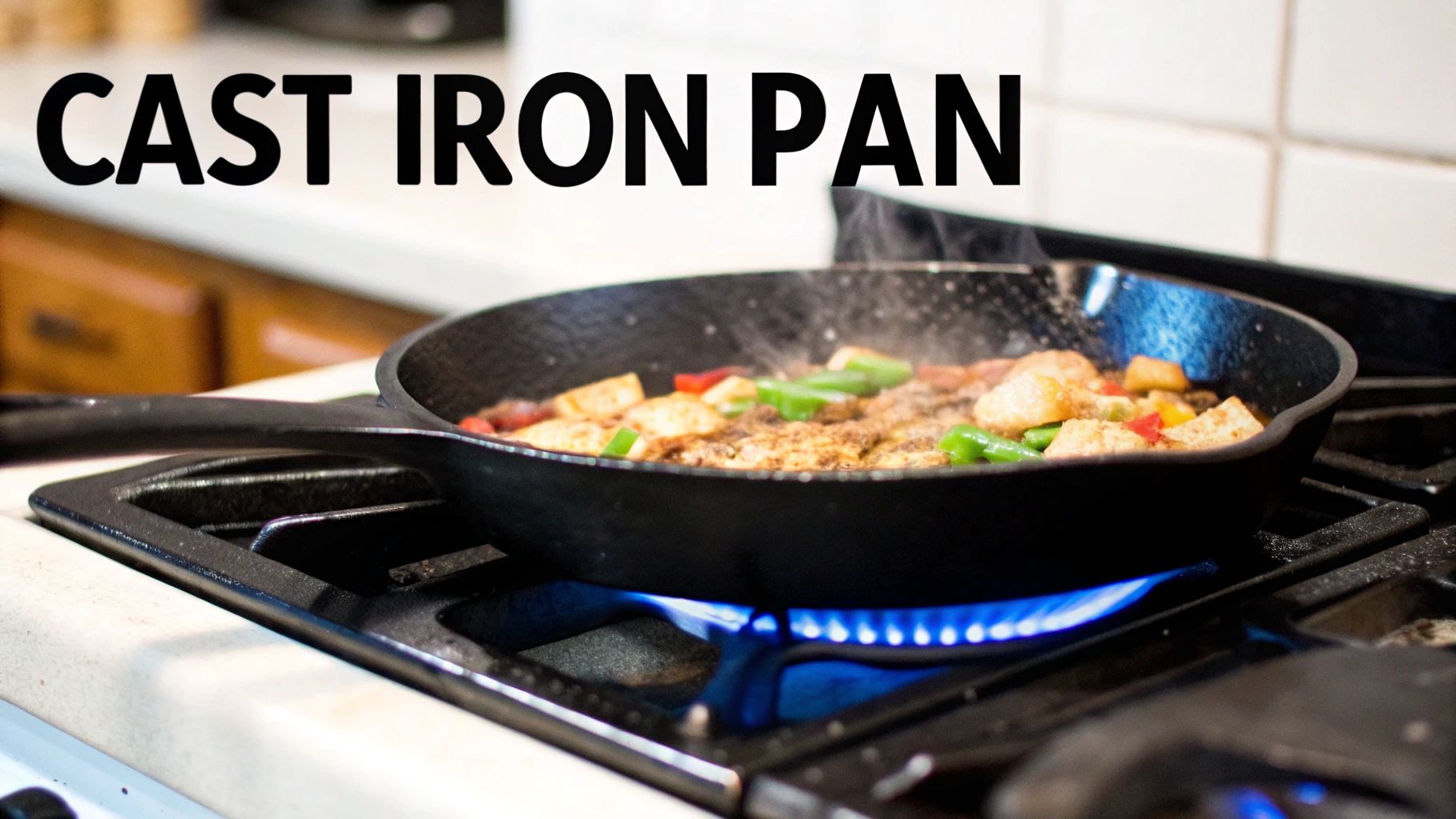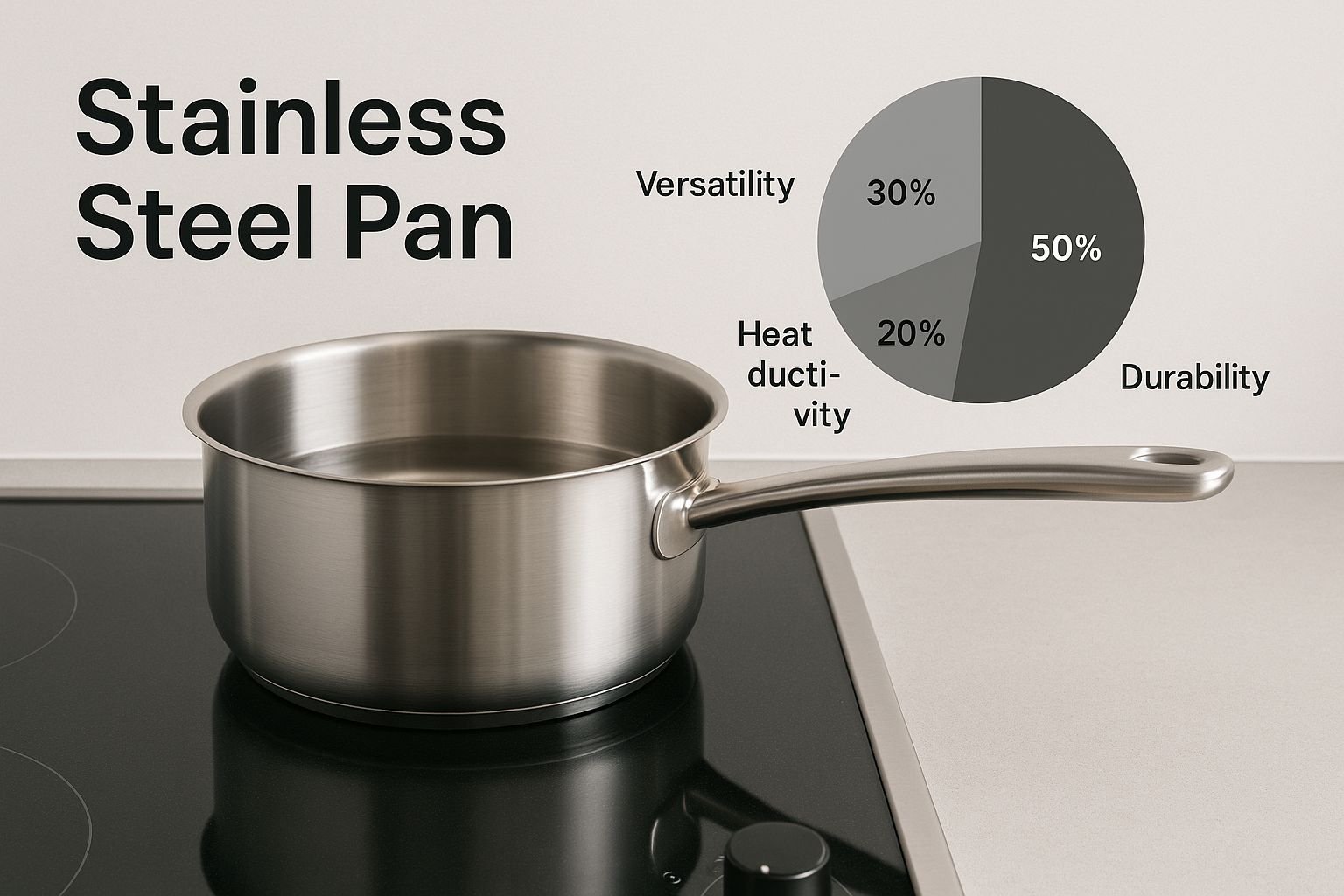
A Pro Chef's Guide to Types of Cooking Pans
Share
When you're equipping a professional kitchen, every single tool matters. But few things have a more direct impact on your final plate than the type of cooking pan you choose. The workhorses of any commercial kitchen—from the all-purpose fry pan to the deep-sided sauté pan—are each built for a specific job, and knowing the difference is key to efficiency and quality. Stay informed about the latest industry trends and exclusive deals on restaurant equipment and supplies to give your kitchen a competitive edge.
Matching the Pan to the Professional Kitchen
A pan isn't just a container for heating food; it's a precision instrument. Think of it like a sculptor's toolkit—you wouldn't use a massive chisel for fine detail work. In the kitchen, the two things that define a pan's purpose are its material and its shape.
The material is all about how the pan handles heat. A heavy cast iron skillet, for example, holds onto heat like nothing else, which is why it’s the go-to for getting a perfect, crusty sear on a steak. On the flip side, copper heats up in a flash and cools down just as quickly, giving a chef the pinpoint control needed for delicate sauces that can easily break or burn. Understanding this relationship is fundamental for any restaurant owner looking to optimize their kitchen.
Why Pan Selection Matters
The pan's shape is just as important because it’s designed to help with specific cooking techniques. A fry pan has flared, sloping sides that make it easy to toss ingredients or slide an omelet right onto the plate. A sauté pan, however, has tall, straight sides designed to hold in liquids and prevent splatters, making it perfect for braising or reducing a pan sauce.
Getting this choice right means you get consistent results every time, which helps streamline the workflow when the kitchen is slammed during a dinner rush.
For any restaurant owner, investing in the right set of pans is as crucial as buying a good oven or walk-in cooler. The right cookware cuts down cooking times, boosts food quality, and ultimately protects your bottom line by performing reliably, service after service. Discover exclusive deals that can help you equip your kitchen for less.
This isn't just anecdotal—it's big business. The global frying pan market was valued at around USD 10 billion in 2023 and is expected to keep growing. You can dive into the full report on the global frying pan market to see how both professional and home-cooking trends are shaping what's available.
Putting together a kitchen from scratch takes a lot of careful thought. For a full rundown of every piece of gear you'll need, be sure to look over our detailed restaurant kitchen equipment list.
To help you get started, here is a quick look at some of the most common pans you'll find in any professional kitchen.
Quick Guide to Common Commercial Kitchen Pans
| Pan Type | Common Materials | Best For |
|---|---|---|
| Fry Pan (Skillet) | Stainless Steel, Cast Iron, Non-Stick | Searing, browning, frying, and sautéing with less liquid. |
| Sauté Pan | Stainless Steel, Copper | Pan-searing, braising, reducing sauces, and cooking dishes with more liquid. |
| Saucepan | Stainless Steel, Aluminum | Boiling, simmering, making sauces, and cooking grains or vegetables. |
| Stock Pot | Stainless Steel, Aluminum | Making stocks, broths, soups, and boiling large batches of pasta or potatoes. |
| Brazier Pan | Cast Iron, Stainless Steel | Braising large cuts of meat, stewing, and slow-cooking on the stovetop. |
This table covers the basics, but each pan has its own set of nuances that make it indispensable for certain tasks. We'll explore each of these in more detail.
Understanding Pan Materials for Heat and Flavor

A pan’s material is its DNA. It determines exactly how it handles heat, which in turn shapes the flavor and texture of everything you cook. In a professional kitchen, knowing which material to grab for a specific task is a core skill. It’s the difference between just cooking and truly controlling the outcome.
Every metal has its own personality—a unique balance of how fast it heats up, how well it holds that heat, how tough it is, and whether it reacts with certain foods. Getting to know these traits means you can pull the perfect pan for any job, whether you're putting a hard sear on a steak or gently simmering a delicate sauce. Stay informed about material innovations to make the best purchasing decisions for your restaurant.
Stainless Steel: The Reliable Workhorse
Walk into almost any commercial kitchen, and you’ll see stainless steel everywhere. There’s a simple reason for that: it’s practically indestructible. This stuff is tough, it won’t react with your ingredients, and it can take the abuse of a busy service night after night. You can simmer a big batch of tomato sauce for hours without ever worrying about a metallic taste.
On its own, steel isn't the best at conducting heat. That’s why the good stuff is always "clad," meaning it has a core of a more conductive metal like aluminum or copper sandwiched between layers of steel. This clever construction gives you the best of both worlds—the even heating of aluminum with the durability and non-reactive surface of steel. It's the ultimate all-rounder.
Cast Iron: The King of Heat Retention
When you need a pan that gets hot and stays screaming hot, nothing comes close to cast iron. Think of it as a thermal battery. Once it's heated, it holds that energy, making it the undisputed champ for searing. That intense, steady heat is what gives you a perfect crust on a piece of meat or blackens fish just right. It won't flinch or cool down when you drop a cold steak into it.
A properly seasoned cast iron pan also builds up a fantastic natural non-stick surface that only gets better the more you use it. The trade-offs? It’s heavy, and you have to maintain it properly to keep rust away. It’s also a reactive metal, so it’s not your first choice for simmering acidic sauces for long periods.
One of the more interesting quirks of cast iron is that it can actually add small amounts of dietary iron to your food. While this can be a nice little health benefit, it's a good reminder that the metal is actively interacting with what's inside it.
Copper: The Precision Instrument
If cookware had a sports car, it would be made of copper. It’s all about speed and responsiveness. Copper has incredible thermal conductivity, meaning it heats up in a flash and, just as importantly, cools down the second you pull it off the heat. This gives a chef pinpoint control over temperature.
That kind of precision is absolutely essential for delicate work where a few degrees can ruin the final product—think candy making, tempering chocolate, or whipping up a finicky hollandaise sauce. But high performance comes at a price. Copper is soft, expensive, and reactive, which is why it's always lined with another metal like tin or steel. It also needs a lot of polishing, making it more of a specialist’s tool than an everyday pan.
Aluminum: The Lightweight Contender
Aluminum is a fantastic heat conductor, right behind copper, but it's much more affordable and way lighter. That light weight is a huge plus for line cooks who are shaking, flipping, and moving pans all night long. You’ll often find aluminum fry pans and saucepans in high-volume kitchens where speed and ease of handling are key.
But raw aluminum has its weaknesses. It's a soft metal, so it can warp and scratch easily. More importantly, it's highly reactive with acidic foods like tomatoes or alkaline ingredients. That’s why most commercial-grade aluminum pans are anodized. This electrochemical process creates a hard, non-reactive surface that makes the pan much more durable and versatile.
Essential Pan Shapes and Their Culinary Purpose

If a pan’s material is all about how it handles heat, its shape is all about technique. The geometry of a pan—the height of its walls, the curve of its base, the total cooking surface—isn't an accident. Each design is engineered to do a specific job, making certain shapes non-negotiable for particular dishes on your menu.
Getting a handle on these purpose-built designs is what separates just heating food from precisely controlling the cooking process. Whether you're containing a delicate sauce or getting that perfect flip on a piece of fish, the right shape makes the job faster, cleaner, and more consistent, especially when the pressure's on during service.
The Sauté Pan vs. The Fry Pan
At first glance, a sauté pan and a fry pan (often called a skillet) look pretty similar. But in the kitchen, they’re built for completely different tasks.
A sauté pan is all about straight, tall sides and a wide, flat bottom. This design gives you the maximum possible surface area for searing. At the same time, those high walls are fantastic for containing liquids, keeping splatter to a minimum, and making it easy to stir a pan sauce or a shallow braise.
On the other hand, a fry pan has flared, sloped sides. This shape is your go-to for high-heat cooking where you're not working with a lot of liquid. The angled walls help moisture evaporate quickly and make it a breeze to toss ingredients with a flick of the wrist. Need to slide a perfectly folded omelet or a delicate fish fillet onto a plate? The fry pan's shape is designed for exactly that.
The rule of thumb is simple: If you’re making a sauce or a braise, grab the sauté pan. If you need to toss, flip, or get food out of the pan fast, the fry pan is the tool for the job.
Specialized Pans for Precision Cooking
Beyond these two kitchen workhorses, you’ll find a whole lineup of pans designed for very specific jobs. Each one solves a unique culinary problem, giving a chef an incredible amount of control over the final plate.
- The Saucier: Think of a saucier as a saucepan that went to finishing school. Its defining feature is a rounded bottom where the walls meet the floor, getting rid of any sharp corners. That curve is absolutely essential for things like custards, risottos, and delicate sauces because it lets a whisk reach every single spot, preventing anything from sticking and scorching.
- The Braiser: This pan is a heavy-hitter. It’s wide, has a thick, heavy bottom, and comes with a tight-fitting lid. It’s built for one thing: slow cooking. The shape is perfect for searing a tough cut of meat right on the stovetop before adding your liquid, popping the lid on, and transferring the whole thing to the oven for a long, slow braise.
- The Wok: With its classic deep, bowl-like shape, the wok is the undisputed king of high-heat stir-frying. The design brilliantly creates different heat zones—an intensely hot area at the very bottom for searing, with cooler temperatures up the sloped sides for holding ingredients that are already cooked.
The world of cookware is always evolving, with new designs popping up to meet specific culinary demands. This innovation is part of a huge market; the global cookware industry was valued at USD 15.70 billion in 2024 and is expected to climb to nearly USD 27.39 billion by 2032. New ideas are constantly emerging, from professional kitchens to the backyard, with items like specialized BBQ pans like the Taco Wok showing how niche cooking styles continue to drive pan design.
Comparing Pan Performance Under Kitchen Pressure
When you're outfitting a commercial kitchen, buying pans isn't just a shopping trip—it's an investment. You need to know exactly how different materials will hold up under the relentless pressure of a busy service. It’s less about how a pan looks and more about how it handles the heat, the food, and the punishing pace of the line.
A pan’s real value comes down to a few key performance traits. We’re talking about its ability to get hot fast (heat conductivity), how well it stays hot (heat retention), whether it reacts with acidic ingredients (reactivity), its overall toughness (durability), and the effort it takes to keep it in prime condition. Nailing these concepts is the secret to making a smart buy and finding exclusive deals on top-performing restaurant equipment.
Performance Indicators Under Pressure
Think of heat conductivity as the pan's accelerator—how quickly it responds when you crank up or kill the heat. Copper is the undisputed champion here, heating up in a flash and giving you incredible control. Aluminum is right on its heels, offering great responsiveness for a much friendlier price.
Heat retention, on the other hand, is all about braking power. Cast iron is the king of holding its temperature. Once it gets hot, it stays hot, delivering that steady, searing heat you need for a perfect crust on a steak. Stainless steel sits comfortably in the middle, balancing decent responsiveness with solid heat retention, making it a reliable workhorse for all sorts of tasks.
The image below gives a great snapshot of stainless steel, a material you’ll find in almost every professional kitchen for good reason.

As you can see, its real strengths are its incredible durability and the fact that it’s non-reactive. That means you can throw just about any ingredient in there without worrying.
The smartest kitchens build an arsenal of cookware, playing to the strengths of each material. You'll see cast iron for searing steaks on a heavy-duty griddle, stainless steel for simmering acidic tomato sauces that would ruin other pans, and lightweight aluminum for the fast-paced egg station.
This kind of thinking—matching the right tool to the right job—is what separates the pros. It's all about efficiency and consistency. For a deeper dive into specialized equipment, our guide on choosing the right Atosa griddle breaks down what to look for in high-volume cooking surfaces.
Performance Comparison of Cooking Pan Materials
To really understand what you're buying, it helps to see how the most common materials stack up against each other. Here’s a side-by-side breakdown of the core performance metrics you should care about in a professional kitchen.
| Material | Heat Conductivity | Heat Retention | Durability | Maintenance Level |
|---|---|---|---|---|
| Stainless Steel | Moderate | Good | Excellent | Low |
| Cast Iron | Low | Excellent | Excellent | High |
| Copper | Excellent | Poor | Moderate | High |
| Aluminum | Very Good | Poor | Good | Low |
| Carbon Steel | Good | Very Good | Excellent | High |
This table makes it clear: there's no single "best" material. The ideal choice always depends on what you're cooking and how you're cooking it. A well-equipped kitchen will have a mix of these, each one ready for the specific task it was born to do.
Care and Maintenance to Maximize Cookware Lifespan
Think of your cookware as a major investment, because it is. Taking care of it isn't just about keeping things clean—it's about protecting that investment, making sure your pans perform reliably day in and day out, and ultimately, saving you money on replacements down the road.
Each pan material has its own set of rules. You can’t treat them all the same. Throw a beautifully seasoned cast iron skillet in a commercial dishwasher, and you’ll strip away that perfect non-stick surface you worked so hard to build. Take steel wool to a copper pan, and you’ll scratch it for good.
Seasoning and Cleaning Cast Iron
Cast iron is the stuff of legends for a reason. It holds heat like nothing else, but it needs a little love through seasoning. Seasoning is just the process of baking oil onto the pan’s surface. This creates a natural, polymerized non-stick layer that actually gets better the more you cook with it.
When it comes to daily cleaning, skip the harsh detergents. A good scrub with hot water and a stiff brush is usually all you need. For really stuck-on gunk, a paste made of coarse salt and a little water works wonders. The most important step? After washing, it is absolutely critical to dry the pan completely—I usually put it back on a low flame for a minute—then wipe a super-thin layer of cooking oil on the inside. This is your shield against rust.
If you’re new to this, a detailed guide on how to season cast iron for your braai is a great resource for getting the technique just right.
Maintaining Stainless Steel and Copper
Stainless steel is the reliable workhorse in most kitchens. It’s tough, but not indestructible. One thing to watch out for is pitting, which looks like tiny corrosion spots. To avoid it, don't let salty or acidic liquids sit in your pans for too long. If you do get burnt-on food, a simple paste of baking soda and water is much gentler and more effective than an abrasive scrubber.
Copper, on the other hand, is the high-maintenance star of the show. It requires consistent attention to keep that beautiful shine and incredible heat conductivity.
- Prevent Tarnishing: Copper naturally darkens when it meets air and heat. You’ll need to polish it regularly with a dedicated copper cleaner or a simple mix of lemon and salt to keep it bright.
- Protect the Lining: Most copper pans have a lining of tin or stainless steel. This lining is what keeps the copper from reacting with your food. Be careful with metal utensils to avoid scratching it.
Proper pan maintenance is a cornerstone of a well-run kitchen. It ensures every piece of equipment performs as expected, from the first service of the day to the last. This consistency is vital for maintaining food quality and operational efficiency.
This philosophy of upkeep goes way beyond your pans. A smart, consistent approach to caring for all your gear can save you thousands in the long run. For a broader look, check out our guide on commercial kitchen equipment maintenance to keep your whole kitchen in top form.
What's New and Trending in Professional Cookware?
The world of professional cookware isn't static. It’s always evolving, with new designs and materials popping up that promise to make life in a busy kitchen a little bit easier and a lot more efficient. For any restaurant owner or chef, keeping an eye on these industry trends is more than just a curiosity—it's about making smart investments in gear that can truly take the heat.
One of the most interesting developments we’re seeing is the rise of hybrid pans. These are a clever blend, combining the raw durability of stainless steel with the easy-release magic of a non-stick surface. They often have a laser-etched steel pattern raised just above the non-stick layer, which lets you get a fantastic sear on a steak while still being a breeze to clean. The big win here is that the design helps protect the non-stick coating, making it last much longer in a demanding commercial kitchen.
A Fresh Look at Materials
We're also seeing a huge comeback for carbon steel. If you haven't used it, think of it as cast iron's lighter, quicker sibling. It seasons up just as beautifully, developing that coveted natural non-stick patina over time. It can also handle screaming-hot temperatures, which makes it an absolute beast for searing meats or for high-heat wok cooking. For line cooks who are constantly moving pans, its lighter weight is a game-changer.
The technology behind ceramic non-stick coatings has also come a long way. The newest ceramic surfaces are way tougher than the old ones, they're made without chemicals like PFOA, and they can handle higher heat. For kitchens focused on sustainability, they’ve become a great eco-friendly alternative that doesn’t compromise on performance.
As restaurant menus go global, so does the pan rack. We're seeing more specialized, authentic cookware in professional kitchens designed for specific cuisines, whether it's a traditional Japanese tamagoyaki pan or a delicate French crepe pan.
This global flavor is part of a much bigger picture. Looking at market trends, the Asia-Pacific region is becoming a massive influence on the future of kitchen gear. In 2023, this region was responsible for over 38% of the global kitchen cookware market revenue, thanks to growing cities and a strong manufacturing base. To get a better sense of what's coming next, it's worth exploring the dominant trends in the kitchen cookware market and how they might impact your kitchen.
Got Questions About Cooking Pans? We've Got Answers.
Stepping into the world of commercial cookware can feel overwhelming. Let's cut through the noise and tackle some of the most common questions we hear from chefs and restaurant owners when they're outfitting their kitchens and looking for the latest news.
What Are The Must-Have Pans For A New Restaurant?
If you're starting from scratch, you need to build a foundation with the real workhorses of the kitchen. Think versatility.
I always tell new owners to start with these essentials:
- A 10-inch and 12-inch stainless steel or cast iron skillet. These are your go-to pans for searing, sautéing, and just about everything else.
- A large, heavy-bottomed sauté pan is non-negotiable for braising, reducing sauces, and handling larger-volume dishes.
- A few different-sized saucepans for, well, sauces, but also for boiling, simmering, and reheating.
Of course, your menu is the ultimate guide, but this core group will get you through the opening rush and handle the bulk of your cooking tasks.
Is It True That More Expensive Pans Are Always Better?
Absolutely not. It's a common misconception that a higher price tag automatically means better performance in a professional kitchen. The real secret is matching the right pan to the right job.
For example, a busy egg station that goes through hundreds of omelets a day is better off with a few durable, commercial-grade aluminum non-stick pans that can be replaced without breaking the bank. Using a pricey, delicate copper pan for that task would be a waste of money and effort.
The real value isn't in the price tag, but in how well a pan performs its specific job, day after day. A smart investment in the right tool for the task will always outperform a mismatched, expensive one.
Focus on practical things like performance, how it stands up to abuse, and whether it's NSF-certified. That's where you'll find the best value and exclusive deals on essential restaurant supplies.
How Can I Tell When It's Time To Toss A Non-Stick Pan?
Think of your non-stick pans as consumables—they have a limited lifespan in a busy kitchen. It's time for a replacement the moment you see the surface is deeply scratched, peeling, or flaking.
Another dead giveaway is when food starts sticking no matter how much oil you use. A damaged non-stick surface isn't just a pain to cook with; it's a genuine food safety risk. Make it a habit for your kitchen crew to inspect them daily to keep your quality and safety standards high.
Here at Encore Seattle Restaurant Equipment, we know that great meals start with the right tools. We help restaurant owners and chefs discover the latest news and exclusive deals on the restaurant equipment and supplies they need. Check out our huge selection of new and used commercial-grade pans built to handle the heat of any professional kitchen. Find what you need to set your team up for success at https://encoreseattle.com.
